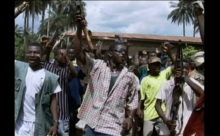Sierra Leone and the Mano River Tri-State Region
The following information about Sierra Leone—the original homeland of many black people enslaved and brought to coastal South Carolina and Georgia—comes from a teachers’ guide published by South Carolina Educational Television to accompany its documentary Family Across the Sea (2003). For more essays from that booklet about the history of slavery and the Gullah language, storytelling, other arts, and history see the homepage for that film on Folkstreams.
Located just under the hump of West Africa on the Atlantic Ocean, the sovereign republic of Sierra Leone is one of the smaller African countries, only a bit larger than South Carolina, with a population of approximately 4 million people. Sierra Leone is in the center of what is called the Mano River region, a tri-state area including Liberia to the south and Guinea to the north.
When Portuguese explorer Pedro de Cintra discovered Sierra Leone in the late 15th century, he found that the mountains bordering the shoreline constantly roared with thunder. He likened this thunder to the sound of lions roaring, and named the place Sierra Leone—"the mountains of the lions."
Despite its small size, the country is divided into four distinct physical regions. The coastal swamp region extends along the Atlantic for 200 miles, a flat, frequently flooded plain some 20 to 40 miles wide. Inland are plains. To the north are grasslands, called Bolilands, a Temne word for lands that flood in the rainy season and are arid in the dry season, on which only grass will grow. The southern plains are rolling, wooded country with isolated hills rising abruptly to more than 700 feet. To the west is a narrow outcrop of mineral-bearing rocks known as the Kambui Schists, behind which stand the Loma Mountains and Tingi Hills, which rise to over 6,000 feet.
Sierra Leone is situated just above the equator. The country's climate is tropical, characterized by wet and dry seasons. The rainy season occurs from May to October, with winds from the southwest bringing rain daily. The dry season brings Saharan winds from the northeast and somewhat cooler temperatures.
There are 18 different ethnic groups in Sierra Leone. The Mɛnde, in the east and south, are the largest, followed by the Temne in the north. Other groups are the Limba, Kuranko, Susu, Yalunka and Loko in the north; the Kono and Kissi in the east; and the Sherbro in the southwest. Minor groups include the coastal Bullom, Vai and Krim, and the Fulani and Malinke (Mandinka) in the north and east.
There are some 42,000 Creoles—descendants of freed slaves, runaways, maroons and "recaptives" who settled the coast around Freetown during the 18th and 19th centuries. They speak Krio, a language derived from English and a variety of African languages, the country's lingua franca, or common language.
The economy centers largely around rice fanning, although fishing is important, as is mining in the western mountains. Freetown, the capital, has the third-largest natural harbor in the world after Rio de Janeiro and Sydney, and is the country's administrative and commercial center. Founded in 1827, Fourah Bay College in Freetown has the distinction of being the oldest institution of higher learning in Sub-Saharan Africa.
Sierra Leone—A Historical Connection
During the 18th century, London was home to many runaway slaves. Their newly acquired freedom, however, was marred by extreme poverty. The British government decided to resettle these former slaves and established the Sierra Leone Company. Sierra Leone was chosen for its supposed habitable climate and potential for monetary returns to the company's proprietors from agriculturally based trade. So in 1787, 400 of these London residents found themselves on the way to West Africa.
At the close of the American revolution, a large number of former slaves who had gained freedom by assisting the British during the war were living in Halifax, Nova Scotia. The British had promised them land and jobs—a promise they were unable to fulfill. These people became the next group to head to Sierra Leone in 1792.
The final two groups to settle Sierra Leone were the Maroons from Jamaica who arrived in 1800, and the "recaptives," Africans on their way to the New World to be sold as slaves who were "recaptured" on the high seas by the British. Also known as "Liberated Africans," they settled in Sierra Leone around 1807.
The settlers built roads, farms and homes. With hard work and perseverance, they eventually established a successful and self-sufficient colony of free black men and women. Ironically, this settlement began and prospered in an area that continued to thrive from the slave trade.
